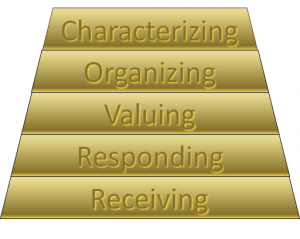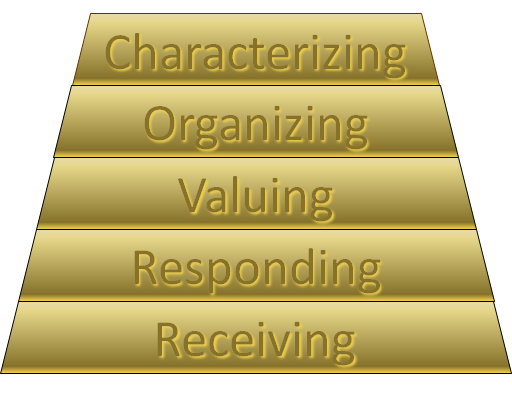We’ve seen in previous blogs how manipulation and fear, while effective short term motivators, bring with them a host of problems. Even if they weren’t wrong in principle, they are a practical disaster.
To begin to remedy the situation, we need to look at several models of how people become Christians. Before the brickbats start, let me state clearly: A model is just that, a model. The real process is more complex, more organic, than any single model can capture. That’s why I will use more than one.
But limited as they are, models still aid us in understanding the process, and how it works. My grad school studies were in Religious Education, so I come at this from a multi-disciplinary approach, and some of it uniquely my own. I’ll try and keep it all clear as I go along.
My first model is something called the “Affective Pyramid,” which describes  how we come to change our beliefs, attitudes, and values. As you can see, it is a five step process. We start from the bottom.
how we come to change our beliefs, attitudes, and values. As you can see, it is a five step process. We start from the bottom.
The first level is simply receiving. It simply means you become aware of the value. It could be something like “The Seventh Day Sabbath,” or simply “Crocheting as a hobby,” or “Golf as recreation.” The first time you hear about some value, belief, or attitude, you are receiving it. Might ask for more information, you might look at something crocheted. you might watch a golf tournament on television. You are simply receiving more input.
At some point, you begin responding. You might find the evidence for the Sabbath convincing. You might like crocheted mittens, but find it frustrating to do. You might find golf interesting, or wonder what the excitement is all about. All of those are responses.
When enough responses accumulate, you reach a decision point, which we call valuing. You might find the Sabbath truth convincing, but decide it is not worth alienating your family and friends over. You might decide you would rather buy something crocheted than to spend your energy on it. You might find golf intriguing, but too time consuming; or it might be just what you need to relax.
From this point onward, I’m going to depart slightly from the standard explanation. Usually, this ranking of one value against another would fit in the “organizing” stage. But I use the pyramid a little differently. For me, simply ranking values in order of importance, or placing them in a constellation of similar values, is too antiseptic and abstract an exercise for real life. I want to be practical. And when it comes to values, mere intellectual assent is worthless.
Lyricist Oscar Hammerstein II wrote, “Love wasn’t put in your heart there to stay, love isn’t love till you give it away.”
Or as many a wife would tell her husband, “Don’t tell me you love me, show me.” For me, a value is not truly valued until it is acted upon. So when I talk about the Organizing stage, I’m talking about how you organize your life to incorporate this new value. If it’s the Sabbath, you’ll have to change your schedule, so that you can observe the Sabbath. If it’s crocheting, you’ll need to by some crochet hooks and yarn and start. If it’s golf, then you’ll need to find time to go to the driving range or rent some clubs and play.
The final step, Characterization, usually means describing the value in detail and distinguishing it from others. Once again, this is far too abstract to be useful for me. So I describe characterization as the stage where the value has become integral to one’s character, one’s being. The famous Martin Luther quote, “Here I stand, I can do no other,” sums it up nicely.
As we will see next time, all our efforts are focused in helping people move from one stage to the other. But not all stages are equal.









